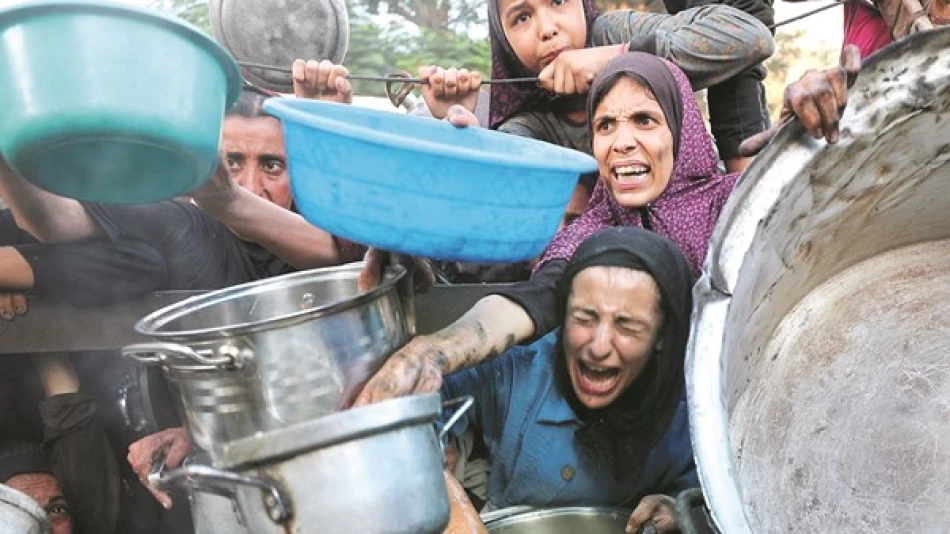
Humanitarian and Rights Groups Mobilize to Combat Alarming Hunger Crisis in Gaza
Gaza Faces Complete Humanitarian Collapse as Aid Workers Join Food Lines
Over 100 humanitarian organizations are sounding an unprecedented alarm as Gaza's food crisis reaches catastrophic levels, with aid workers now joining the same food queues as desperate civilians. The Palestinian Health Ministry reported 10 new deaths from famine and malnutrition in just 24 hours, bringing the total death toll from starvation to 111 people—a stark indicator of how completely the humanitarian system has collapsed after 21 months of war.
International Health Leaders Declare Man-Made Famine
World Health Organization Director-General Tedros Adhanom Ghebreyesus delivered a blunt assessment to journalists: "A large part of Gaza's population is starving. I don't know what else this can be called other than mass famine, and it is man-made." His statement carries particular weight given the WHO's typically cautious diplomatic language around conflict zones.
The French Foreign Ministry echoed this assessment, directly linking the famine risk to Israel's blockade of the territory. This represents a significant diplomatic shift, with European allies increasingly willing to assign direct responsibility for the humanitarian crisis.
Aid System Reaches Breaking Point
The Norwegian Refugee Council revealed that its aid supplies have been completely exhausted for 145 days, with hundreds of trucks containing tents, water, food, and educational materials blocked from entering Gaza. Perhaps most telling, some of the organization's own staff are now fainting from hunger while trying to carry out their duties.
The scale of the blockade is staggering: UNRWA conducted nearly 74,000 screenings for malnutrition among children under five between March and June, identifying approximately 5,500 cases of severe acute malnutrition and over 800 cases of severe acute malnutrition requiring immediate intervention.
When Helpers Become Victims
Jan Egeland, Secretary-General of the Norwegian Refugee Council, described the unprecedented situation: "There are hundreds of truck loads sitting in warehouses or in Egypt or elsewhere, costing Western European donors a lot of money, but they are prohibited from entering... Relief workers are now joining the same food lines, risking bombardment just to feed their families."
This represents a fundamental breakdown of the humanitarian system. In previous conflicts—from Syria to Yemen—aid organizations typically maintained some operational capacity even under siege conditions. Gaza's situation appears unique in its totality.
The Mathematics of Starvation
The humanitarian organizations' joint statement, signed by 111 groups including Mercy Corps and Refugees International, highlights a cruel irony: tons of food, clean water, and medical supplies sit just outside Gaza's borders while the population faces mass starvation. The Norwegian Refugee Council alone has been unable to deliver supplies to 100,000 people in central and northern Gaza who had been receiving water assistance.
Child malnutrition rates doubled between March and June, according to UNRWA data—a rate of deterioration that suggests systematic rather than incidental food access problems. In comparison, even during the worst periods of the Syrian siege warfare, humanitarian corridors typically allowed some supplies through.
Diplomatic Implications and Precedent
The 111 organizations are demanding governments take concrete measures, including halting arms transfers—a call that goes beyond traditional humanitarian appeals into the realm of military and diplomatic pressure. This represents an escalation in humanitarian advocacy, similar to calls made during the Bosnian crisis of the 1990s.
Israel denies blocking aid access and accuses Hamas of stealing food supplies, which Hamas refutes. However, the sheer number of international organizations reporting identical access problems suggests systemic rather than tactical obstacles.
A Crisis Without Modern Parallel
What distinguishes Gaza's current crisis from other humanitarian disasters is the complete breakdown of the international aid system itself. When organizations like the Norwegian Refugee Council—which operates in some of the world's most challenging environments—report that their own staff are starving, it signals a humanitarian collapse that exceeds even the worst-case scenarios typically planned for in crisis response.
The situation has forced a fundamental question about international humanitarian law and the responsibility to protect civilian populations. With 111 deaths now officially attributed to starvation and aid workers themselves becoming victims, Gaza represents a test case for whether the international humanitarian system can function under conditions of total siege.
Most Viewed News

 Layla Al Mansoori
Layla Al Mansoori






